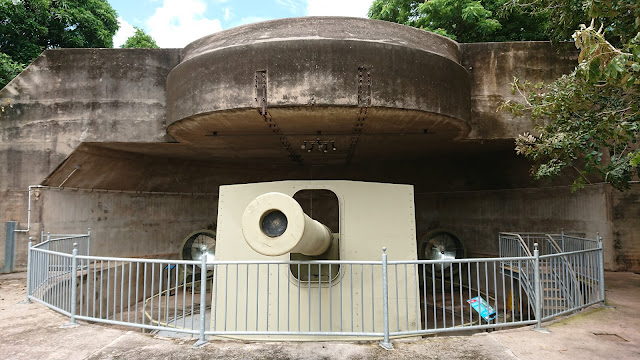On 19 February 1942 Australia suffered its first foreign attack since the British invaded as Japanese aircraft bombed Darwin. Around 250 lives were lost in this, the first of 90 or so attacks on military installations in the Northern Territory during World War Two.
Darwin was a supply base for Australian and Allied forces resisting the Japanese expansion in the region, making it a target for attacks. It is a role that it continues to play today.
We get our initiation into Darwin's wartime history at the Darwin Military Museum at picturesque Fannie Bay. The museum is located at the site of Darwin's main naval battery and incorporates one of the massive nine inch guns in its concrete emplacement.
A modern multimedia presentation and interactive exhibits introduce the first battle and many of the characters involved. The music was a bit derivative and at one point I expected Gary Oldman to appear as Dracula.
Outside the museum is a beautiful tropical garden in which are embedded a large variety of military vehicles and artillery pieces from World War Two and beyond. Inside the command bunkers are displays of medals, personal equipment and weapons.
The most interesting to me are the big gun sighting equipment and World War Two targeting computers, utilising parallax and mechanical computing to calculate optimal paths based on wind, humidity and other measurements. These giants boxes are replaced by microcomputers providing far more speed and flexibility.
I'm in trouble with the others for taking too long in the museum and they are hungry when I emerge to join them. We head into the city centre and find a couple more SE Asian cafes to try.
Asian Pot, run by a Singaporean, has run out of chicken for the day, so Alex orders a seafood laksa that is better than the last couple but not really up to standard. It also contains broccoli.
The adjacent Ayuriz Indonesian Cafe serves a much better nasi goreng than I had yesterday and their nasi lemak with beef rendang is very nice.
Stokes Hill Wharf is our next destination, but the Royal Flying Doctor Service Experience has closed early on thus public holiday. The wharf itself features a number of seafood eateries, but we are now full.
A tugboat moors at the wharf, exhaust tubes jutting up like spiky organ pipes. We head back to our accommodation to rest and have a swim in the pool.
We head out to the Bicentennial Park to admire the tropical sunset and find more information about Darwin's history. The famous sunset is beautiful and we watch the boats chug past while dragonflies flit overhead.
Dinner presents many problems. First we try Frying Nemo near the marina, but that is closed, then out to the Stokes Hill Wharf again, only to find the car park absolutely full. The same could be said of the restaurants at the Waterfront. Eventually we drive into the city centre and find a Vietnamese restaurant outside where we had lunch. The meals take over half an hour to arrive and we are ready for bed.
What I didn't mention earlier was our first destination of the day, the tourist office. We were investigating the option of Kakadu. We rejected the single day coach tour option and chose to drive there instead and stay a night at the Mercure. I couldn't book it when I tried myself. So another long drive tomorrow and a need to get sleep tonight.



















Comments